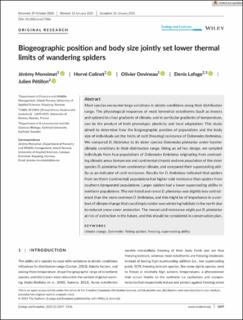| dc.contributor.author | Monsimet, Jeremy | |
| dc.contributor.author | Collinet, Hervé | |
| dc.contributor.author | Devineau, Olivier | |
| dc.contributor.author | Lafage, Denis | |
| dc.contributor.author | Pétillon, Julien | |
| dc.date.accessioned | 2021-11-12T14:13:59Z | |
| dc.date.available | 2021-11-12T14:13:59Z | |
| dc.date.created | 2021-03-07T12:11:52Z | |
| dc.date.issued | 2021 | |
| dc.identifier.citation | Ecology and Evolution. 2021, 11 (7), 3347-3356. | en_US |
| dc.identifier.issn | 2045-7758 | |
| dc.identifier.uri | https://hdl.handle.net/11250/2829393 | |
| dc.description.abstract | Most species encounter large variations in abiotic conditions along their distribution range. The physiological responses of most terrestrial ectotherms (such as insects and spiders) to clinal gradients of climate, and in particular gradients of temperature, can be the product of both phenotypic plasticity and local adaptation. This study aimed to determine how the biogeographic position of populations and the body size of individuals set the limits of cold (freezing) resistance of Dolomedes fimbriatus. We compared D. fimbriatus to its sister species Dolomedes plantarius under harsher climatic conditions in their distribution range. Using an ad hoc design, we sampled individuals from four populations of Dolomedes fimbriatus originating from contrasting climatic areas (temperate and continental climate) and one population of the sister species D. plantarius from continental climate, and compared their supercooling ability as an indicator of cold resistance. Results for D. fimbriatus indicated that spiders from northern (continental) populations had higher cold resistance than spiders from southern (temperate) populations. Larger spiders had a lower supercooling ability in northern populations. The red-listed and rarest D. plantarius was slightly less cold tolerant than the more common D. fimbriatus, and this might be of importance in a context of climate change that could imply colder overwintering habitats in the north due to reduced snow cover protection. The lowest cold resistance might put D. plantarius at risk of extinction in the future, and this should be considered in conservation plan. | en_US |
| dc.language.iso | eng | en_US |
| dc.rights | Navngivelse 4.0 Internasjonal | * |
| dc.rights.uri | http://creativecommons.org/licenses/by/4.0/deed.no | * |
| dc.title | Biogeographic position and body size jointly set lower thermal limits of wandering spiders | en_US |
| dc.type | Peer reviewed | en_US |
| dc.type | Journal article | en_US |
| dc.description.version | publishedVersion | en_US |
| dc.source.pagenumber | 3347-3356 | en_US |
| dc.source.volume | 11 | en_US |
| dc.source.journal | Ecology and Evolution | en_US |
| dc.source.issue | 7 | en_US |
| dc.identifier.doi | 10.1002/ece3.7286 | |
| dc.identifier.cristin | 1896148 | |
| cristin.ispublished | true | |
| cristin.fulltext | original | |
| cristin.qualitycode | 1 | |

